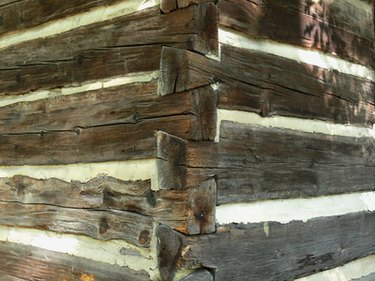Things You'll Need
2 log supports
Iron dogs or spikes
Level
Chalk line
Measuring tape
Felling axe
Broadaxe
Adz
Eye protection

Hand-hewn wood beams, with their picturesque patterns of axe marks, are part of the charm of old houses or barns. If you want to hew your own beams, you'll need two main tools, a regular axe, also called a felling axe, and a broadaxe. To find a broadaxe, check antique stores for an axe with a wide blade that's angled on one side and straight on the other like a chisel. It should have a short handle, only about 2 feet long, that slants away from the flat side to protect your knuckles when you swing it.
Step 1
Prop the log 1 1/2 to 2 feet off the ground by rolling it or lifting it onto two short logs laid crosswise, or heavy-duty sawhorses. Stabilize the log so it won't roll during hewing. Traditional hewers used iron "dogs," shaped like large staples. They pounded one end into the support and one into the log. You can also use spikes pounded into the support or simply let the log settle into a broad notch in the supports with the curve of the log down so gravity holds it in place. If you'll be hewing only two of the four sides, place the log so the sides you don't want to hew are on the top and bottom.
Video of the Day
Step 2
Hold a level vertical against the smaller end of the log and mark two lines where you want the two finished vertical sides. Do the same at the other end of the log, spacing the vertical lines the same distance apart.
Step 3
Put on your safety goggles or other eye protection. Clear off any stubs of branches or rough bark with an axe or hatchet, and snap a chalk line connecting the tops of the vertical marks along the lengths of the log.
Step 4
Using a felling axe, score roughly V-shaped notches down to the line on one side of the log. Space the notches about every 6 to 12 inches. The traditional method is to stand on top of the log and swing the axe between your spread feet, chopping out the notch while sighting down from above to make sure it's vertical. Compare the notches with a level held vertically or a plumb bob to make sure they're reasonably well aligned. Do the same on the other side of the log.
Step 5
Stand beside the log and swing downward at an angle with a broadaxe to hew away the remaining wood between the notches. Use a broadaxe with a short, angled handle to prevent your knuckles from hitting the log. Check again with a level or plumb bob to make sure you're hewing the side vertically.
Step 6
If you want it hewn on all four sides, turn the log 90 degrees and repeat.
Step 7
Finish the hewn surfaces with an adz if you want them smoother, though builders often left hand-hewn beams with their broadaxe finish. Turn the side that you want to work on so it's facing up, stand on the log or straddle it, and swing the adz toward you into the wood, similar to using a hoe. The adz is lighter than the broadaxe and leaves a smoother, rippled surface.
Tip
Some people prefer to cut the notches with the log turned so the notches are horizontal. If you don't want to use traditional tools throughout, you can cut the notches with a chainsaw.
Warning
Be careful when using axes and other sharp tools. Work from a position that you find safe and comfortable.
Wear safety goggles or other eye protection.
Video of the Day